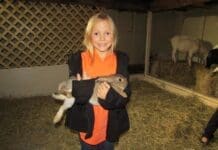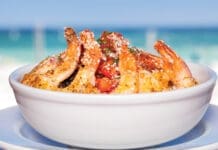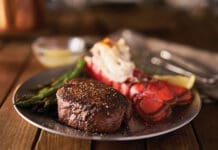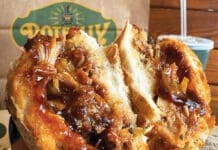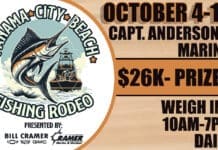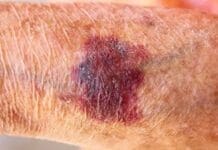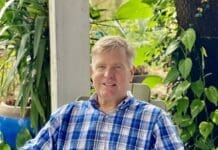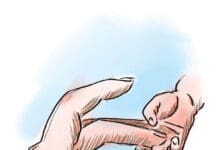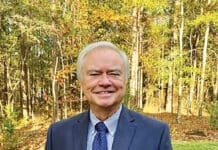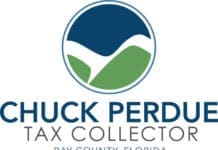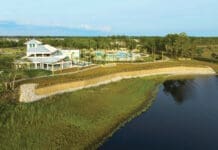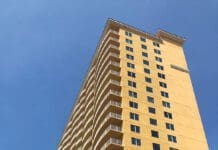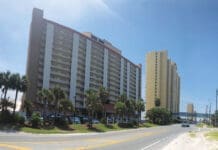 By Julie McConnell, UF/IFAS Extension Bay County
By Julie McConnell, UF/IFAS Extension Bay County
Palms are synonymous with Florida landscapes, but a lot of people aren’t really sure how to care for them. I get a lot of calls about palms in decline and although there isn’t always a single cause, one maintenance practice I see that contributes to several palm problems is improper pruning.
Although the Cabbage Palm is Florida’s state tree, it’s not technically a tree but surprisingly is a grass. In addition to that taxonomy trivia point there are important physiological differences between palms and shade trees. Most palms have only one growing point or bud, called the apical meristem which is located at the top of the trunk. Every frond generates from this bud over a period of about 4-6 months. As new fronds emerge, older fronds are pushed lower creating a naturally full, rounded canopy.
Palm Nutrition
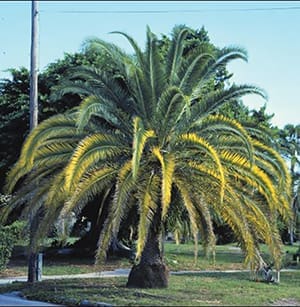 It’s a common misconception that yellowing lower fronds is a sign that the older leaf is ready to drop. However, gradual discoloration is usually an indication of a nutrient deficiency, not senescence. Our soils are often deficient in specific nutrients that the bud needs to create new leaves. Yellowish orange speckles or brown edges on lower fronds is a sign that the bud is pulling mobile nutrients (usually Potassium and Magnesium) from older leaves to make healthy new ones. So, if you cut those fronds off while there is still green tissue, you made a nutrient deficiency worse!
It’s a common misconception that yellowing lower fronds is a sign that the older leaf is ready to drop. However, gradual discoloration is usually an indication of a nutrient deficiency, not senescence. Our soils are often deficient in specific nutrients that the bud needs to create new leaves. Yellowish orange speckles or brown edges on lower fronds is a sign that the bud is pulling mobile nutrients (usually Potassium and Magnesium) from older leaves to make healthy new ones. So, if you cut those fronds off while there is still green tissue, you made a nutrient deficiency worse!
Plants make their own food through photosynthesis. You can get really complicated with this process, but the basic role of leaves involve chlorophyll (the green in those leaves!) trapping sunlight followed by a chemical reaction that creates glucose (energy for plant) and oxygen. When you remove green leaves, you reduce the palm’s ability to create food for itself in addition to potentially intensifying a nutrient deficiency.
Disease Transmission
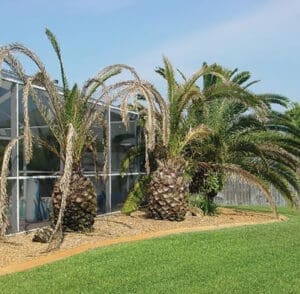 Unsanitary pruning equipment can transmit plant pathogens. One devastating disease transmitted through contaminated pruning equipment is Fusarium Wilt of Canary Island Date Palm. This fungus affects the vascular system resulting in wilted fronds and eventual death of the palm. Pruning an infected palm then moving to a healthy one without proper sterilization can transmit the fungus. The pathogen can be spread before symptoms appear in the infected palm, so preventing spread can be tricky. There is no cure for this disease and because fungal spores can remain viable in the soil or root fragments left behind it is not recommended to replace infected palms with the same species.
Unsanitary pruning equipment can transmit plant pathogens. One devastating disease transmitted through contaminated pruning equipment is Fusarium Wilt of Canary Island Date Palm. This fungus affects the vascular system resulting in wilted fronds and eventual death of the palm. Pruning an infected palm then moving to a healthy one without proper sterilization can transmit the fungus. The pathogen can be spread before symptoms appear in the infected palm, so preventing spread can be tricky. There is no cure for this disease and because fungal spores can remain viable in the soil or root fragments left behind it is not recommended to replace infected palms with the same species.
Attracting Insects
When a plant is injured it produces volatile compounds that can be detected by insects. An injured plant is under stress and this can be a beneficial time for an insect to attack since the plant may have a reduced capacity to protect itself. An example of this type of plant-pest relationship is the Palmetto Weevil. Originally considered a minor pest of the native cabbage palm and saw palmetto, it has expanded its host base to include Canary Island Date, Washingtonia, Royal, Coconut, Bismark, and Latan palms which are less tolerant of weevil damage. A wounded palm emits an odor that is detected by an adult male palmetto weevil. The male finds the palm and begins to feed then releases an aggregation pheromone. This chemical brings in more adults which feed on the palm, mate, and lay eggs in wounds or leaf bases. The larvae that hatch are grubs that feed on the soft tissue surrounding the apical meristem (bud) which can cause rot in the canopy leading to bud death or canopy collapse. Larvae form cocoons out of palm fibers and pupate in the periphery of stems or petioles. By the time symptoms of infestation are obvious treatment is ineffective and the recommendation is to remove and destroy the palm.
If you’d like to learn more about palm care visit https://edis.ifas.ufl.edu/topic_palm_care for a variety of topics including pruning, fertilization and nutrition, diseases and pests of palms.
An Equal Opportunity Institution. UF/IFAS Extension, University of Florida, Institute of Food and Agricultural Sciences, Nick T. Place, Dean for UF/IFAS Extension. Single copies of UF/IFAS Extension publications (excluding 4-H and youth publications) are available free to Florida residents from county UF/IFAS Extension offices.


